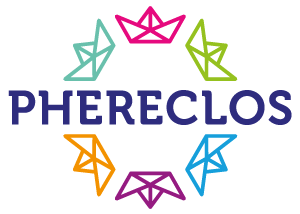E-FABRIK
- France,Paris, France
- 2015

| Time frame | |
| Categories | |
| Level of Schools | |
| External Partners | |
| Type of Schools | |
| URL | |
| Number of Schools involved | |
| Number of Schoolheads involved | |
| Number of Teachers involved | |
| Number of Students involved | |
| Number of Parents involved | |
| Number of External Partners involved |
E-FABRIK is a workshop program, where people with disabilities and young people — unaccompanied foreign minors and school dropouts — learn to use digital resources to develop concrete solutions to a difficulty expressed by the disabled people in the group. During those workshops the participants are accompanied by tutors, designers, makers and educators with whom they develop a personal relationship.
E-FABRIK has 5 main objectives:
Bringing together young people and people with disabilities in a creative community. Designing and building real and open-source solutions for disabilities.
Learning new digital tools by applying and developing new competences.
Seizing new technologies through active solidarity and becoming an actor in its territory. Linking organizations from different fields: disability, youth and digital creativity.
E-FABRIK is a 20-workshop program, divided in 5 phases: Getting to know each other
Identifying, drawing, exploring Discovering and training Prototyping, testing, improving Celebrating
Regardless of the target group, participants are encouraged to complete the project season and overcome difficulties together. One of the great successes is that no group has abandoned anyone during a project. The success of E-FABRIK is also its ability to include and mobilize new audiences, thanks to multiple possible entries in the project alongside its dimensions: social, technical, disability, digital etc.
More perennially, E-FABRIK has observed:
Strengthening and / or creating social links between the young people of diverse backgrounds and people with disabilities;
Increase in independent attendance in places of digital creativity by these audiences. This autonomy by the participants has also given rise to particular institutional changes in the later stage (e.g. welcoming of disabled audiences in FabLab).
The creation / reinforcement of partnership dynamics between neighboring structures that are brought together within the framework of the project, notably in the 16 targeted areas, half of which are located in underprivileged neighborhoods.
The project allows young people without access to digital innovation to reclaim technology through an active and concrete solidarity, to better control their environment and to be actively involved.
Additionally, it links places of innovative digital and technical creativity with other places of non-formal education and engages people who work there to create a territorial dynamic.
Theatrical pedagogical framework: Problem-based Learning / Learning by doing / Project-based learning / Community-based education
Tools: Pedagogical guide and evaluation tools.
E-FABRIK has to seize opportunities to work with communities outside their comfort zone. In doing so, the project can be innovative and promote social links.
During the workshops participants are engaged in:
- designing and building real and open-source solutions for disabilities.
- learning new digital tools by applying and developing new competences.
Moreover, the participants are accompanied by "accomplices" (tutors, designers, makers, educators), with whom they develop a personal relationship. But above all, placed in a problem solving situation (to conceive a useful object), they acquire skills as diverse as the respect of commitments, the attitude towards the difficulty of the other, the capacity to help each other, the use of complex digital tools and many more.
During the workshops, where all the group is focused on the problem solving situation (to conceive a useful object), participants acquire skills as diverse as the respect of commitments, the attitude towards the difficulty of the other, the capacity to help each other, the use of complex digital tools and many more.
The project put together young people aged between 15 and 25, disabled people of all ages and adult professionals of different fields.
During all workshops, the participants are accompanied by "accomplices" (tutors, designers, makers, educators), with whom they develop a personal relationship.
E-FABRIK works on 3 different levels of inclusion:
digital education youth disabilities
Moreover E-FABRIK is one of the few digital education projects that has a perfect gender balance of its beneficiaries. During the experiment, girls accounted for 49.6% of their beneficiaries.
The design process of the prototypes entails to combine knowledge from different disciplines, such as engineering, informatics, mathematics and physics.
In order to realize prototypes that could actually address disable people problems, participants have to integrate theoretical knowledge and practical skills from different disciplines, such as engineering, informatics, mathematics and physics.
The piloting of E-FABRIK is carried out by 4 employees of the Traces association that represent 2,5 full-time persons (FTE). E-FABRIK also has a scientific board, which represents designers, teachers, special need educators, funding partners and other stakeholders.
The project supports the creation / reinforcement of partnership dynamics between neighboring structures that are brought together within the framework of the project, notably in the 16 targeted areas, half of which are located in underprivileged neighborhoods.
A season of E-FABRIK ends with a festive and unifying regional event that includes all the participants and people involved. The objective of this event is to give recognition to the participants and their achievements. E-FABRIK did fit into a governmental funding scheme that aimed to enhance digital, but regional authorities also provided part of the funding. This had no direct impact on the nature and structure of the initiative, but without this initial funding, the initiative may not have been so ambitious from the early beginning. After 3 years of implementation, E-FABRIK is now receiving more local support.
The new TRACES board also includes partners from the E-FABRIK network, which means the board is now closer to the “new” inclusive values developed during the implementation of the project itself.
From E-FABRIK project a spin-off has born: a 5-month personal and professional training program for young people who wish to:
> Build an innovative and original professional project
> Invent and create new and useful objects for the handicap
> Learn how to use digital manufacturing tools (3D printer, laser cutter, connected objects, etc.)
> Meet and work with people with disabilities
> Participate in a collective adventure and solidarity with other young people
E-FABRIK targets young people, with a special focus on those who live the furthest from digital innovation. Thanks to the local partnerships set up with neighborhood structures, E-FABRIK was able to reach young people with limited use and knowledge of ICT (often limited to Facebook, YouTube and Snapchat on their mobile phone). They stay attracted by the solidarity dimension of the project and the digital tools offered.
The cooperation among partners in the E-FABRIK project seemed to be very fruitful in many aspects. After 3 years from its beginning also local entities are contributing economically to the project.
Cooperation among local partners and Traces, the leading organization, is fundamental for the sustainability of the project, by accompanying the structures of the partners and their participants to an autonomous project management.
Indeed both TRACES and E-FABRIK boards now also include partners from the E-FABRIK network: designers, teachers, special need educators, funding partners and other stakeholders
Disable and youth centers are liable in engaging people and providing spaces. FabLab and similar organizations provide facilities and expertise.
E-FABRIK was created by Céline Martineau and Vanessa Mignan, two project managers of Traces.
From their field experience with young people, they have learned that when it comes to the appropriation of scientific concepts, there is not so much a question of access to knowledge as of creating an interest in it, which is a relevant prerequisite for its acquisition. The same goes for digital education: The learning must be accompanied by a personal significance for the learner. This is how E-FABRIK was initiated: giving a meaning development of digital literacy through the social link.
Martineau and Mignan were also inspired by digital communities and the movements that encourage the individual and collective creativity, even the re-appropriation of the technological and digital production of objects and ideas.
E-FABRIK has both a quantitative and a qualitative evaluation through questionnaires and interviews: Formative – based on the course of the project
Summative –based on training and interactions between apprentices and associates at E-FABRIK Summative – based on the impact
E-FABRIK`s indicator of success, besides the number of participants and project completions, are continuously assessed by means of focus groups for qualitative data and collection of quantitative data and are the following:
- strengthening or creating the link between people with disabilities
- to frequent and use, autonomously, places of digital creation
- produce and share solutions around disability
- become an active citizen in your neighborhood, your city
- get involved in solidarity, on a daily basis
- transmit to these peers and others
- reclaiming digital tools and using open-source
- involving the community of accomplices in a dynamic of territory, with its inhabitants
- allow professionals from the concerned territories to meet and continue to work together
- highlight the strengths and constraints of the project
- create a multi-partnership network of structures, working in very different fields
- valuing and disseminating, to spread
